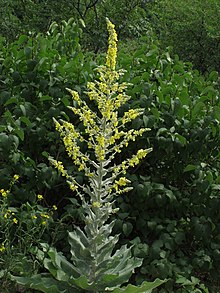| Verbascum pulverulentum | |
|---|---|

| |
| Plant in flower in Italy | |

| |
| Stem and leaves in Germany, showing the dense pale hairs | |
| Scientific classification | |
| Kingdom: | Plantae |
| Clade: | Tracheophytes |
| Clade: | Angiosperms |
| Clade: | Eudicots |
| Clade: | Asterids |
| Order: | Lamiales |
| Family: | Scrophulariaceae |
| Genus: | Verbascum |
| Species: | V. pulverulentum |
| Binomial name | |
| Verbascum pulverulentum Vill. | |
| Synonyms | |
List
| |
Verbascum pulverulentum, the hoary mullein, is a species of flowering plant in the family Scrophulariaceae. It is native to western, central and southern Europe north to England (where its main range is in East Anglia) and southern Wales. It has been introduced to Austria, Madeira, and Washington state in the USA. It is a specialist on coastal shingle, and so is preadapted to human-influenced habitats such as old quarries and gravel pits, road verges, railway embankments, and similar disturbed stony ground.
It is a stout biennial or monocarpic perennial herb growing up to 1.5 m tall, producing flowers and seeds only once, during its second or a later year. The stems and leaves are densely woolly with pale grey to glaucous pubescence. The flowers are yellow, 18–25 mm diameter, with 5 orange stamens, all the stamen stems with dense white hairs. It can best be distinguished from the similar great mullein (V. thapsus) in all five stamens having dense white hairs on the stem; in V. thapsus, the lower two of the five stamens are hairless or only thinly hairy.
It is the main food plant for the moth Nothris verbascella (Norfolk snout).
References
- ^ "Verbascum pulverulentum Vill". Plants of the World Online. Board of Trustees of the Royal Botanic Gardens, Kew. Retrieved 15 October 2021.
- ^ P. A. Stroh; T. A. Humphrey; R. J. Burkmar; O. L. Pescott; D. B. Roy; K. J. Walker, eds. (2020). "Hoary Mullein Verbascum pulverulentum Vill". BSBI Online Plant Atlas 2020. Botanical Society of Britain and Ireland. Retrieved 5 September 2024.
- "Verbascum pulverulentum - Vill". pfaf.org. Plants For A Future. 2021. Retrieved 15 October 2021.
- "Verbascum pulverulentum hoary mullein". The Royal Horticultural Society. 2021. Retrieved 15 October 2021.
- "Verbascum pulverulentum". brc.ac.uk/plantatlas. Online Atlas of the British and Irish flora. 2021. Archived from the original on 28 October 2021. Retrieved 15 October 2021.
{{cite web}}: CS1 maint: bot: original URL status unknown (link) - ^ Streeter D, Hart-Davies C, Hardcastle A, Cole F, Harper L. 2009. Collins Flower Guide. Harper Collins ISBN 9-78-000718389-0
- Blamey, M. & Grey-Wilson, C. (1989). Flora of Britain and Northern Europe. ISBN 0-340-40170-2
- "35.015 Norfolk Snout Nothris verbascella ([Denis & Schiffermüller], 1775)". British and Irish Moths. Retrieved 5 September 2024.
| Taxon identifiers | |
|---|---|
| Verbascum pulverulentum |
|